河南专升本考试英语语法系列复习专题——动词时态-被动语态
- 格式:doc
- 大小:43.50 KB
- 文档页数:9
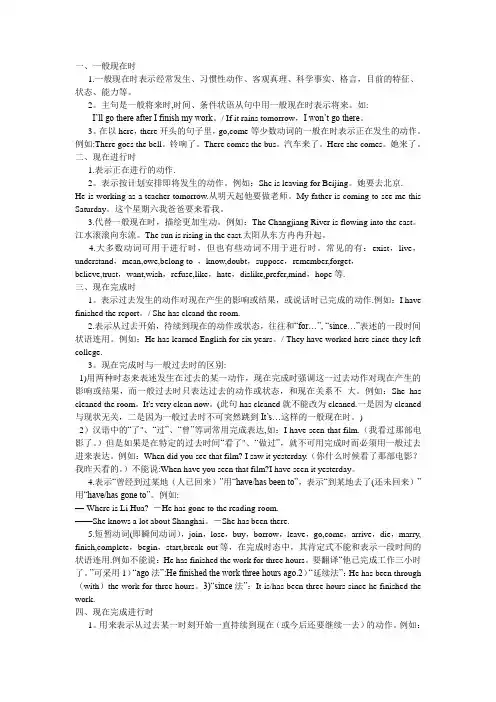
一、一般现在时1.一般现在时表示经常发生、习惯性动作、客观真理、科学事实、格言,目前的特征、状态、能力等。
2。
主句是一般将来时,时间、条件状语从句中用一般现在时表示将来。
如:I’ll go there after I finish my work。
/ If it rains tomorrow,I won’t go there。
3。
在以here,there开头的句子里,go,come等少数动词的一般在时表示正在发生的动作。
例如:There goes the bell。
铃响了。
There comes the bus。
汽车来了。
Here she comes。
她来了。
二、现在进行时1.表示正在进行的动作.2。
表示按计划安排即将发生的动作。
例如:She is leaving for Beijing。
她要去北京.He is working as a teacher tomorrow.从明天起他要做老师。
My father is coming to see me this Saturday。
这个星期六我爸爸要来看我。
3.代替一般现在时,描绘更加生动。
例如:The Changjiang River is flowing into the east。
江水滚滚向东流。
The sun is rising in the east.太阳从东方冉冉升起。
4.大多数动词可用于进行时,但也有些动词不用于进行时。
常见的有:exist,live,understand,mean,owe,belong to ,know,doubt,suppose,remember,forget,believe,trust,want,wish,refuse,like,hate,dislike,prefer,mind,hope等.三、现在完成时1。
表示过去发生的动作对现在产生的影响或结果,或说话时已完成的动作.例如:I have finished the report。
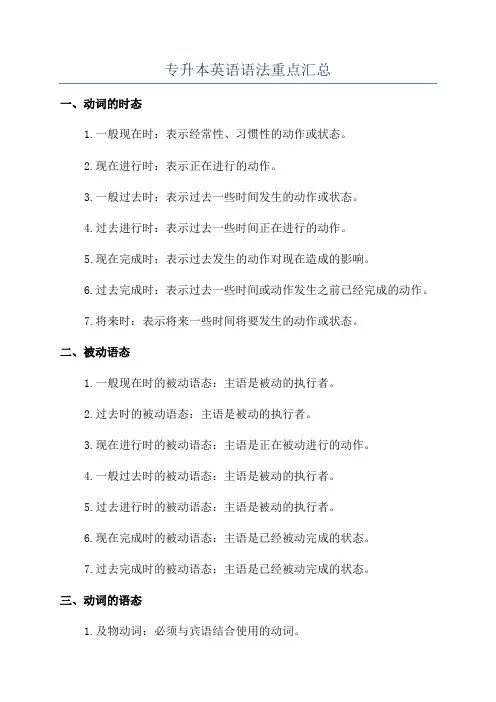
专升本英语语法重点汇总一、动词的时态1.一般现在时:表示经常性、习惯性的动作或状态。
2.现在进行时:表示正在进行的动作。
3.一般过去时:表示过去一些时间发生的动作或状态。
4.过去进行时:表示过去一些时间正在进行的动作。
5.现在完成时:表示过去发生的动作对现在造成的影响。
6.过去完成时:表示过去一些时间或动作发生之前已经完成的动作。
7.将来时:表示将来一些时间将要发生的动作或状态。
二、被动语态1.一般现在时的被动语态:主语是被动的执行者。
2.过去时的被动语态:主语是被动的执行者。
3.现在进行时的被动语态:主语是正在被动进行的动作。
4.一般过去时的被动语态:主语是被动的执行者。
5.过去进行时的被动语态:主语是被动的执行者。
6.现在完成时的被动语态:主语是已经被动完成的状态。
7.过去完成时的被动语态:主语是已经被动完成的状态。
三、动词的语态1.及物动词:必须与宾语结合使用的动词。
2.不及物动词:不需要与宾语结合使用的动词。
四、倒装句1.完全倒装:把助动词或情态动词放在主语前。
2.部分倒装:把助动词或情态动词放在谓语动词前。
五、情态动词1. can:表示能力、许可、可能。
2. could:表示过去的能力、许可、可能。
3. may:表示允许、可能。
4. might:表示过去可能。
5. must:表示推测、必须。
6. shall:表示将来的意愿。
7. should:表示建议、应该。
8. will:表示将来。
9. would:表示过去习惯、愿意。
六、名词1.可数名词:可以用来计数的名词。
2.不可数名词:不可以用来计数的名词。
3.特殊名词变复数形式。
4.特殊名词变单数形式。
七、形容词和副词1.形容词在句中的位置。
2.形容词比较级和最高级。
3.副词在句中的位置。
4.副词比较级和最高级。
五、代词1.主格代词:作为主语的代词。
2.宾格代词:作为宾语的代词。
3.物主代词:表示所属关系的代词。
4.反身代词:表示动作反过来作用于自己的代词。
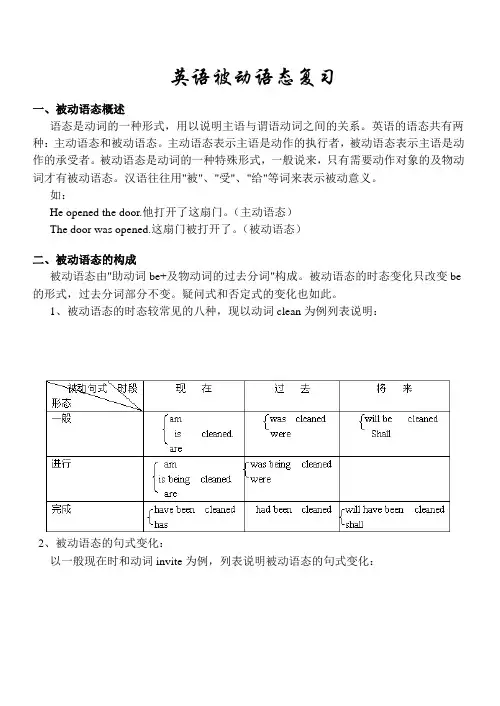
英语被动语态复习一、被动语态概述语态是动词的一种形式,用以说明主语与谓语动词之间的关系。
英语的语态共有两种:主动语态和被动语态。
主动语态表示主语是动作的执行者,被动语态表示主语是动作的承受者。
被动语态是动词的一种特殊形式,一般说来,只有需要动作对象的及物动词才有被动语态。
汉语往往用"被"、"受"、"给"等词来表示被动意义。
如:He opened the door.他打开了这扇门。
(主动语态)The door was opened.这扇门被打开了。
(被动语态)二、被动语态的构成被动语态由"助动词be+及物动词的过去分词"构成。
被动语态的时态变化只改变be 的形式,过去分词部分不变。
疑问式和否定式的变化也如此。
1、被动语态的时态较常见的八种,现以动词clean为例列表说明:2、被动语态的句式变化:以一般现在时和动词invite为例,列表说明被动语态的句式变化:3、含有情态动词的被动语态情态动词的被动语态结构为:情态动词+be+过去分词;其时态及句型的变化仅由情态动词完成,"be+过去分词"部分不变。
如:Tables can be made of stone.桌子可由石头制造。
Tables could be made of stone at that time. 那时桌子可由石头制造。
(一般过去时)Can tables be made of stone? 桌子能用石头制造吗?(疑问句)三、主动语态变为被动语态转换图示:1、主动语态变为被动语态的步骤:(1)将主动句的宾语变为主语:注意:如果主动句的宾语是代词,需将其由宾格变为主格。
如:Tom killed him. →He was killed by Tom.(2)将动词改为"be+过去分词"。
注意:They held a meeting yesterday. → A meeting was held by them yesterday.他们昨天开会了。
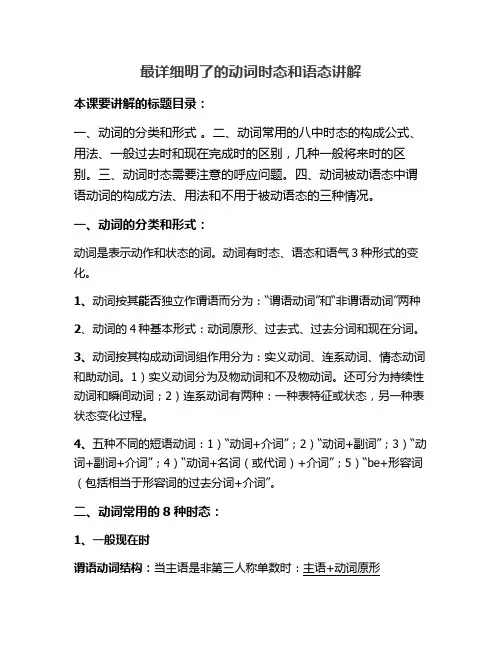
最详细明了的动词时态和语态讲解本课要讲解的标题目录:一、动词的分类和形式。
二、动词常用的八中时态的构成公式、用法、一般过去时和现在完成时的区别,几种一般将来时的区别。
三、动词时态需要注意的呼应问题。
四、动词被动语态中谓语动词的构成方法、用法和不用于被动语态的三种情况。
一、动词的分类和形式:动词是表示动作和状态的词。
动词有时态、语态和语气3种形式的变化。
1、动词按其能否独立作谓语而分为:“谓语动词”和“非谓语动词”两种2、动词的4种基本形式:动词原形、过去式、过去分词和现在分词。
3、动词按其构成动词词组作用分为:实义动词、连系动词、情态动词和助动词。
1)实义动词分为及物动词和不及物动词。
还可分为持续性动词和瞬间动词;2)连系动词有两种:一种表特征或状态,另一种表状态变化过程。
4、五种不同的短语动词:1)“动词+介词”;2)“动词+副词”;3)“动词+副词+介词”;4)“动词+名词(或代词)+介词”;5)“be+形容词(包括相当于形容词的过去分词+介词”。
二、动词常用的8种时态:1、一般现在时谓语动词结构:当主语是非第三人称单数时:主语+动词原形当主语是第三人称单数时:主语+动词的第三人称单数形式(动词的词尾要加-S)(规则:一般的动词词尾+S.以sh/ch/s/x结尾的词+es.以辅音字母Y结尾的把Y变成i,+es.辅音字母+o结尾的+es.) 。
一般现在时的用法:1)表示现在的习惯,经常发生的动作或存在的状态。
如:I often get up early in the morning .He likes reading in the afternoon.2)表示客观事实或真理及自然现象,此用法即使出现在过去语境中,也用一般现在时态。
如:The sun rises in the east.3)用于here,there开头的倒装句中,一般现在时表示正在发生的动作或存在的状态。
如:There goes the bell. Here comes the bus.2、一般过去时态谓语动词构成:主语+动词的过去式动词的过去式是在动词原形的基础上变化而来的,一般是在词尾加上ed.动词的过去式可分为规则动词和不规则动词.规则动词的过去式变化如下:一般情况下,动词词尾加 -ed ,如: work-ed, play-ed ,want-ed. Act-ed 等词。
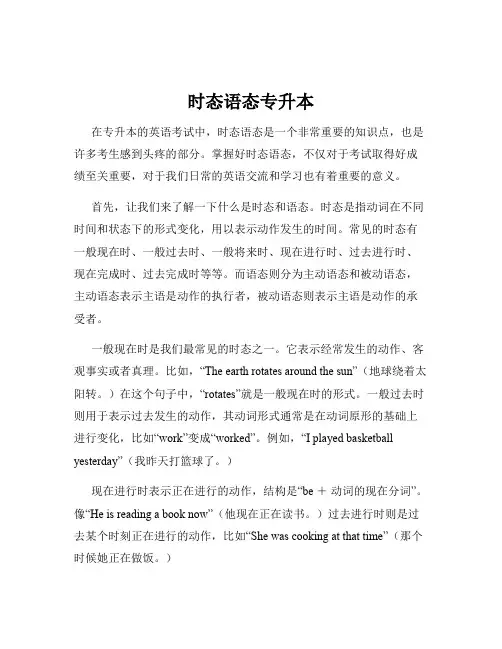
时态语态专升本在专升本的英语考试中,时态语态是一个非常重要的知识点,也是许多考生感到头疼的部分。
掌握好时态语态,不仅对于考试取得好成绩至关重要,对于我们日常的英语交流和学习也有着重要的意义。
首先,让我们来了解一下什么是时态和语态。
时态是指动词在不同时间和状态下的形式变化,用以表示动作发生的时间。
常见的时态有一般现在时、一般过去时、一般将来时、现在进行时、过去进行时、现在完成时、过去完成时等等。
而语态则分为主动语态和被动语态,主动语态表示主语是动作的执行者,被动语态则表示主语是动作的承受者。
一般现在时是我们最常见的时态之一。
它表示经常发生的动作、客观事实或者真理。
比如,“The earth rotates around the sun”(地球绕着太阳转。
)在这个句子中,“rotates”就是一般现在时的形式。
一般过去时则用于表示过去发生的动作,其动词形式通常是在动词原形的基础上进行变化,比如“work”变成“worked”。
例如,“I played basketball yesterday”(我昨天打篮球了。
)现在进行时表示正在进行的动作,结构是“be +动词的现在分词”。
像“He is reading a book now”(他现在正在读书。
)过去进行时则是过去某个时刻正在进行的动作,比如“She was cooking at that time”(那个时候她正在做饭。
)现在完成时是一个比较复杂但又很常用的时态。
它表示过去发生的动作对现在造成的影响或者结果,结构是“have/has +动词的过去分词”。
例如,“I have finished my homework”(我已经完成了作业。
)过去完成时则是过去的过去所发生的动作,通常要与一个过去的时间点作对比,比如“By the time I arrived, they had already left”(我到的时候,他们已经离开了。
)再来说说语态。
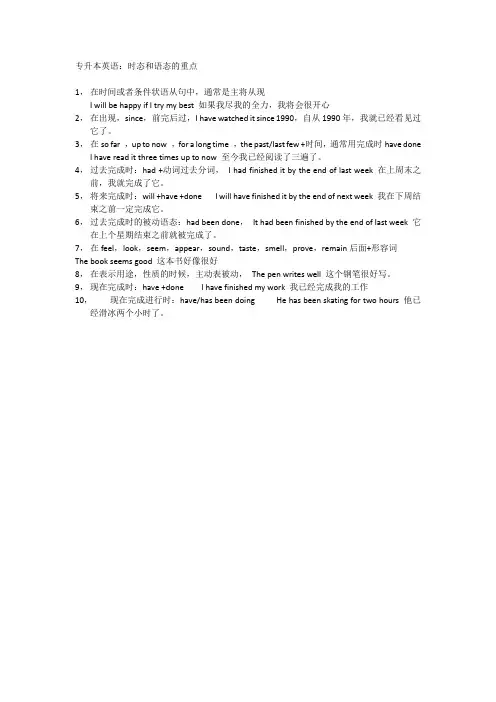
专升本英语:时态和语态的重点1,在时间或者条件状语从句中,通常是主将从现I will be happy if I try my best 如果我尽我的全力,我将会很开心2,在出现,since,前完后过,I have watched it since 1990,自从1990年,我就已经看见过它了。
3,在so far ,up to now ,for a long time ,the past/last few +时间,通常用完成时have doneI have read it three times up to now 至今我已经阅读了三遍了。
4,过去完成时:had +动词过去分词,I had finished it by the end of last week 在上周末之前,我就完成了它。
5,将来完成时:will +have +done I will have finished it by the end of next week 我在下周结束之前一定完成它。
6,过去完成时的被动语态:had been done,It had been finished by the end of last week 它在上个星期结束之前就被完成了。
7,在feel,look,seem,appear,sound,taste,smell,prove,remain后面+形容词The book seems good 这本书好像很好8,在表示用途,性质的时候,主动表被动,The pen writes well 这个钢笔很好写。
9,现在完成时:have +done I have finished my work 我已经完成我的工作10,现在完成进行时:have/has been doing He has been skating for two hours 他已经滑冰两个小时了。
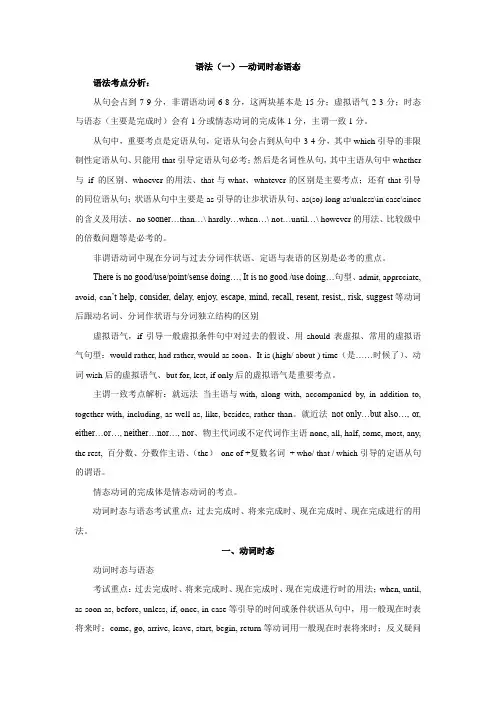
语法(一)—动词时态语态语法考点分析:从句会占到7-9分,非谓语动词6-8分,这两块基本是15分;虚拟语气2-3分;时态与语态(主要是完成时)会有1分或情态动词的完成体1分,主谓一致1分。
从句中,重要考点是定语从句,定语从句会占到从句中3-4分,其中which引导的非限制性定语从句、只能用that引导定语从句必考;然后是名词性从句,其中主语从句中whether 与if 的区别、whoever的用法、that与what、whatever的区别是主要考点;还有that引导的同位语从句;状语从句中主要是as引导的让步状语从句、as(so) long as\unless\in case\since 的含义及用法、 no sooner…than…\ hardly…when…\ not…until…\ however的用法、比较级中的倍数问题等是必考的。
非谓语动词中现在分词与过去分词作状语、定语与表语的区别是必考的重点。
There is no good/use/point/sense doing…, It is no good /use doing…句型、admit, appreciate, avoid, can’t help, consider, delay, enjoy, escape, mind, recall, resent, resist,, risk, suggest等动词后跟动名词、分词作状语与分词独立结构的区别虚拟语气,if引导一般虚拟条件句中对过去的假设、用should表虚拟、常用的虚拟语气句型:would rather, had rather, would as soon、It is (high/ about ) time(是……时候了)、动词wish后的虚拟语气、but for, lest, if only后的虚拟语气是重要考点。
主谓一致考点解析:就远法当主语与with, along with, accompanied by, in addition to, together with, including, as well as, like, besides, rather than。
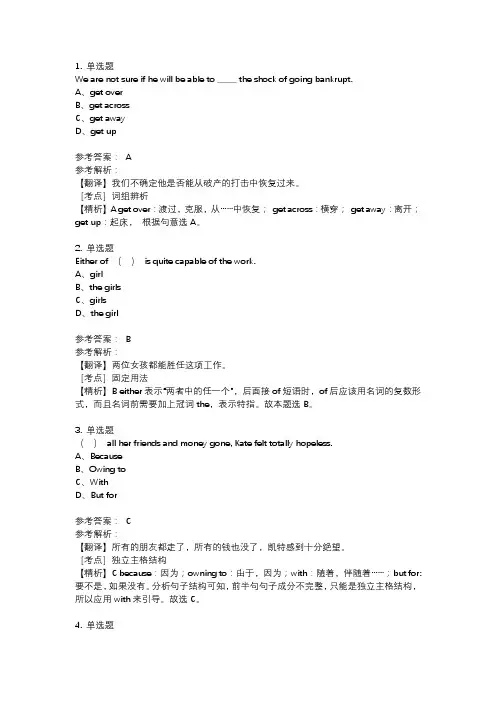
1. 单选题We are not sure if he will be able to _____ the shock of going bankrupt.A、get overB、get acrossC、get awayD、get up参考答案:A参考解析:【翻译】我们不确定他是否能从破产的打击中恢复过来。
[考点]词组辨析【精析】A get over:渡过,克服,从……中恢复;get across:横穿;get away:离开;get up:起床,根据句意选A。
2. 单选题Either of ()is quite capable of the work.A、girlB、the girlsC、girlsD、the girl参考答案:B参考解析:【翻译】两位女孩都能胜任这项工作。
[考点]固定用法【精析】B either表示“两者中的任一个”,后面接of短语时,of后应该用名词的复数形式,而且名词前需要加上冠词the,表示特指。
故本题选B。
3. 单选题()all her friends and money gone, Kate felt totally hopeless.A、BecauseB、Owing toC、WithD、But for参考答案:C参考解析:【翻译】所有的朋友都走了,所有的钱也没了,凯特感到十分绝望。
[考点]独立主格结构【精析】C because:因为;owning to:由于,因为;with:随着,伴随着……;but for:要不是,如果没有。
分析句子结构可知,前半句句子成分不完整,只能是独立主格结构,所以应用with来引导。
故选C。
4. 单选题_____ forget the days when we lived in the countryside.A、Never I shallB、Never shall IC、I never shallD、Never do I shall参考答案:B参考解析:【精析】B句意:我永远也不会忘记我们住在乡村的那些日子。
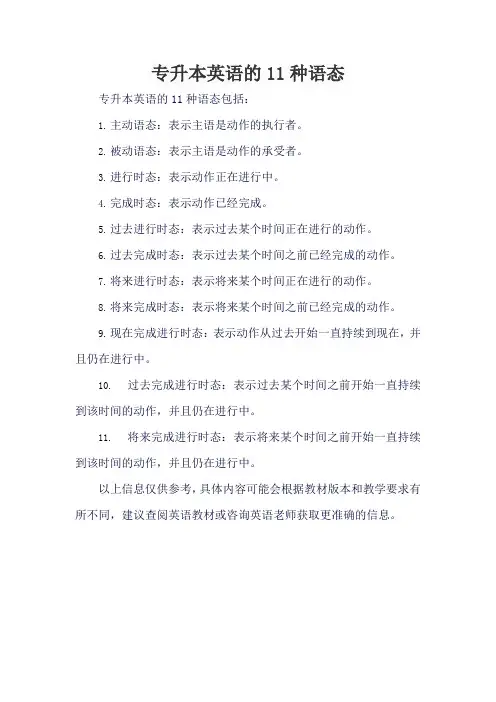
专升本英语的11种语态
专升本英语的11种语态包括:
1.主动语态:表示主语是动作的执行者。
2.被动语态:表示主语是动作的承受者。
3.进行时态:表示动作正在进行中。
4.完成时态:表示动作已经完成。
5.过去进行时态:表示过去某个时间正在进行的动作。
6.过去完成时态:表示过去某个时间之前已经完成的动作。
7.将来进行时态:表示将来某个时间正在进行的动作。
8.将来完成时态:表示将来某个时间之前已经完成的动作。
9.现在完成进行时态:表示动作从过去开始一直持续到现在,并且仍在进行中。
10.过去完成进行时态:表示过去某个时间之前开始一直持续到该时间的动作,并且仍在进行中。
11.将来完成进行时态:表示将来某个时间之前开始一直持续到该时间的动作,并且仍在进行中。
以上信息仅供参考,具体内容可能会根据教材版本和教学要求有所不同,建议查阅英语教材或咨询英语老师获取更准确的信息。
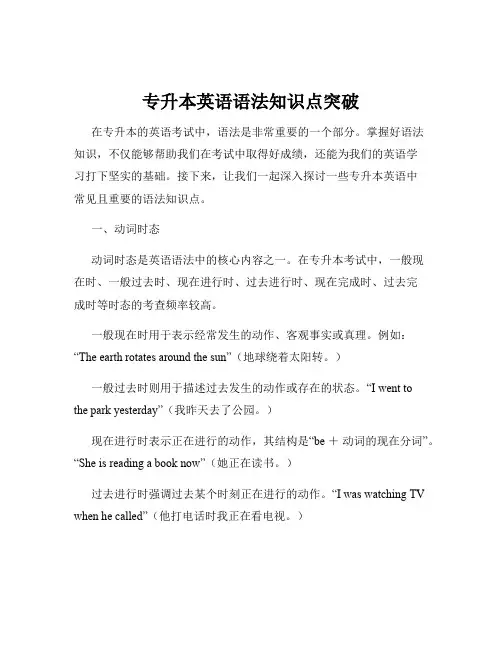
专升本英语语法知识点突破在专升本的英语考试中,语法是非常重要的一个部分。
掌握好语法知识,不仅能够帮助我们在考试中取得好成绩,还能为我们的英语学习打下坚实的基础。
接下来,让我们一起深入探讨一些专升本英语中常见且重要的语法知识点。
一、动词时态动词时态是英语语法中的核心内容之一。
在专升本考试中,一般现在时、一般过去时、现在进行时、过去进行时、现在完成时、过去完成时等时态的考查频率较高。
一般现在时用于表示经常发生的动作、客观事实或真理。
例如:“The earth rotates around the sun”(地球绕着太阳转。
)一般过去时则用于描述过去发生的动作或存在的状态。
“I went tothe park yesterday”(我昨天去了公园。
)现在进行时表示正在进行的动作,其结构是“be +动词的现在分词”。
“She is reading a book now”(她正在读书。
)过去进行时强调过去某个时刻正在进行的动作。
“I was watching TV when he called”(他打电话时我正在看电视。
)现在完成时表示过去发生的动作对现在造成的影响或结果,或者从过去开始一直持续到现在的动作。
“I have learned English for five years”(我学英语已经五年了。
)过去完成时表示过去某个时间之前已经完成的动作。
“By the end of last year, I had finished reading three novels”(到去年年底,我已经读完了三本小说。
)二、被动语态被动语态在英语中也经常出现。
其基本结构是“be +过去分词”。
被动语态的使用通常是为了强调动作的承受者或者不知道动作的执行者。
例如:“The window was broken by the boy”(窗户被那个男孩打破了。
)在不同的时态中,被动语态的形式也会有所变化。
比如,一般现在时的被动语态是“am/is/are +过去分词”,一般过去时的被动语态是“was/were +过去分词”。
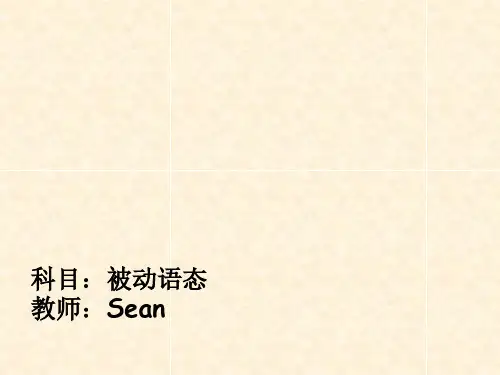
一、一般现在时1.一般现在时表示经常发生、习惯性动作、客观真理、科学事实、格言,目前的特征、状态、能力等。
2.主句是一般将来时,时间、条件状语从句中用一般现在时表示将来。
如:I’ll go there after I finish my work./ If it rains tomorrow,I won’t go there.3.在以here,there开头的句子里,go,come等少数动词的一般在时表示正在发生的动作。
例如:There goes the bell.铃响了。
There comes the bus.汽车来了。
Here she comes.她来了。
二、现在进行时1.表示正在进行的动作。
2.表示按计划安排即将发生的动作。
例如:She is leaving for Beijing.她要去北京。
He is working as a teacher tomorrow.从明天起他要做老师。
My father is coming to see me this Saturday.这个星期六我爸爸要来看我。
3.代替一般现在时,描绘更加生动。
例如:The Changjiang River is flowing into the east.江水滚滚向东流。
The sun is rising in the east.太阳从东方冉冉升起。
4.大多数动词可用于进行时,但也有些动词不用于进行时。
常见的有:exist,live,understand,mean,owe,belong to ,know,doubt,suppose,remember,forget,believe,trust,want,wish,refuse,like,hate,dislike,prefer,mind,hope等。
三、现在完成时1.表示过去发生的动作对现在产生的影响或结果,或说话时已完成的动作。
例如:I have finished the report./ She has cleand the room.2.表示从过去开始,待续到现在的动作或状态,往往和“for…”, “since…”表述的一段时间状语连用。
高考英语基础语法:动词时态与被动语态详解在高考英语中,动词时态和被动语态是语法的重要组成部分,对于准确理解和表达英语句子的含义起着关键作用。
下面,咱们就来详细地探讨一下这两个重要的语法点。
首先,咱们来聊聊动词时态。
动词时态简单来说就是表示动作发生的时间和状态。
英语中常见的时态有一般现在时、一般过去时、一般将来时、现在进行时、过去进行时、将来进行时、现在完成时、过去完成时和将来完成时等。
一般现在时通常用于表示经常发生的动作、客观事实或真理。
比如说,“The sun rises in the east”(太阳从东方升起。
)这就是一个客观事实,用一般现在时。
再比如,“I play basketball every weekend”(我每个周末都打篮球。
)这里表示经常发生的动作。
一般过去时呢,则是用来描述过去发生的动作。
“I went to Beijing last year”(我去年去了北京。
)在这个句子里,“went”就是过去式,表示过去的动作。
一般将来时是用于表示将来要发生的动作。
“I will go to the cinema tomorrow”(我明天要去电影院。
)“will +动词原形”就体现了将来时态。
现在进行时表示正在进行的动作。
“I am reading a book now”(我现在正在读书。
)“be +动词的现在分词”构成现在进行时。
过去进行时用于描述过去某个时刻正在进行的动作。
“I was watching TV at 8 o'clock yesterday evening”(昨天晚上 8 点我正在看电视。
)将来进行时相对用得少一些,它表示将来某个时刻正在进行的动作。
比如,“This time next week, I will be having a meeting”(下周这个时候,我将正在开会。
)现在完成时表示过去发生的动作对现在造成的影响或结果。
“I have finished my homework”(我已经完成了作业。
英语语法被动语态知识点梳理在英语语法中,被动语态是一个重要且常用的语法点。
理解和掌握被动语态对于准确、流畅地表达意思以及提高英语语言能力都有着至关重要的作用。
下面咱们就来详细梳理一下被动语态的相关知识。
一、被动语态的构成被动语态的基本构成是“be +过去分词”。
其中,“be”动词要根据不同的时态和主语进行变化,过去分词则保持不变。
比如,一般现在时的被动语态是“am/is/are +过去分词”,一般过去时是“was/were +过去分词”,现在进行时是“am/is/are + being +过去分词”,过去进行时是“was/were + being +过去分词”,现在完成时是“have/has + been +过去分词”,过去完成时是“had + been +过去分词”等等。
举几个例子帮助大家理解:“ The book is written by him ”(一般现在时的被动语态)“ The tree was cut down yesterday ”(一般过去时的被动语态)“ The problem is being discussed now ”(现在进行时的被动语态)“ The work had been finished before he came ”(过去完成时的被动语态)二、被动语态的使用场景1、不知道或没必要指出动作的执行者当我们关注的是动作本身而不是执行者时,就会使用被动语态。
例如:“The window was broken ”(不知道是谁打破了窗户)2、强调动作的承受者为了突出动作的承受者,会使用被动语态。
比如:“This song is loved by many people ”(强调很多人喜欢这首歌,而不是强调谁让很多人喜欢这首歌)3、出于礼貌或委婉在某些情况下,使用被动语态可以使表达更委婉、更礼貌。
比如:“It is suggested that you should come earlier ”(用被动语态比直接说“ We suggest that you should come earlier ”更委婉)三、主动语态变被动语态的方法1、把主动语态中的宾语变成被动语态的主语。
61. This is the very house () my grandpa lived before his death in 1980.A、whichB、thatC、whenD、where参考答案: D参考解析:【翻译】我祖父在1980年去世之前一直住在这栋房子里。
[考点]定语从句【精析】D在定语从句中,选关系代词还是关系副词关键看从句中缺少什么成分,缺主语、宾语这类基本成分选关系代词,缺状语时选关系副词或“介词+which/whom”。
由题干可知,本句缺少的是表示地点的关系副词,故选D。
注意,这里容易因the very而误选that,但that是关系代词,不符合句子结构要求。
62. Ten minutes _____ an hour when one is expecting a phone call.A、seemsB、seemedC、seemD、to seem参考答案: A参考解析:【翻译】当一个人正在等电话时,十分钟就像一个小时那样漫长。
[考点]主谓一致【精析】A本句描述的是一种心理状态,故应用一般现在时态;又因当时间、距离、金钱等的复数名词作主语时,通常看作一个整体,谓语动词应用单数形式,故本题应选A。
63. I, _____ your good friend, will try my best to help you out.A、who isB、who amC、that isD、which am参考答案: B参考解析:【精析】B句意:我,作为你的好朋友,会尽全力帮你走出困境。
定语从句题。
一般来说,定语从句中的谓语形式应与先行词保持一致,本句中先行词是I,所以后面应用who am;而C项不能引导非限制性定语从句,D项的先行词不能是人,故选B项。
64. Mr. Green said his clients _____ our samples by the end of last month.A、didn’t receiveB、hadn’t receivedC、haven’t receivedD、don’t receive参考答案: B参考解析:【精析】B句意:格林先生说,截止到上个月月底他的顾客还没有收到我们的样品。
专升本英语时态和语态专升本英语中,时态包括一般现在时态、一般过去时态、一般将来时态、现在进行时态、过去进行时态、现在完成时态、过去完成时态、将来完成时态、一般将来过去时态、过去将来进行时态等。
语态包括主动语态和被动语态。
在主动语态中,主语是动作的执行者;在被动语态中,主语是动作的接受者。
以下是一些常见的时态和语态的用法:一般现在时态:表示经常性的动作、习惯、客观真理等。
例句:He often goes to the gym.(他经常去健身房。
)一般过去时态:表示过去发生的动作或状态。
例句:I studied English last night.(昨晚我学习了英语。
)一般将来时态:表示将来发生的动作或状态。
例句:They will arrive at 8 o'clock tomorrow.(明天他们将会在8点到达。
)现在进行时态:表示现在正在进行的动作。
例句:We are watching a movie now.(我们现在正在看电影。
)过去进行时态:表示过去某个时间点正在进行的动作。
例句:She was sleeping when I called her last night.(昨晚我联系她时她正在睡觉。
)现在完成时态:表示过去发生的动作对现在的影响或结果。
例句:I have finished my homework.(我已经完成了我的作业。
)过去完成时态:表示过去某个时间点之前已经完成的动作。
例句:He had left before I arrived.(在我到达之前他已经离开了。
)一般将来过去时态:表示过去某个时间点之后将来发生的动作。
例句:She told me that she would call me later.(她告诉我她会稍后给我打电话。
)以上仅为部分时态和语态的用法,还有其他更多的时态和语态需要根据具体语境进行使用。
一、一般现在时1.一般现在时表示经常发生、习惯性动作、客观真理、科学事实、格言,目前的特征、状态、能力等。
2.主句是一般将来时,时间、条件状语从句中用一般现在时表示将来。
如:I’ll go there after I finish my work./ If it rains tomorrow,I won’t go there.3.在以here,there开头的句子里,go,come等少数动词的一般在时表示正在发生的动作。
例如:There goes the bell.铃响了。
There comes the bus.汽车来了。
Here she comes.她来了。
二、现在进行时1.表示正在进行的动作。
2.表示按计划安排即将发生的动作。
例如:She is leaving for Beijing.她要去北京。
He is working as a teacher tomorrow.从明天起他要做老师。
My father is coming to see me this Saturday.这个星期六我爸爸要来看我。
3.代替一般现在时,描绘更加生动。
例如:The Changjiang River is flowing into the east.江水滚滚向东流。
The sun is rising in the east.太阳从东方冉冉升起。
4.大多数动词可用于进行时,但也有些动词不用于进行时。
常见的有:exist,live,understand,mean,owe,belong to ,know,doubt,suppose,remember,forget,believe,trust,want,wish,refuse,like,hate,dislike,prefer,mind,hope等。
三、现在完成时1.表示过去发生的动作对现在产生的影响或结果,或说话时已完成的动作。
例如:I have finished the report./ She has cleand the room.2.表示从过去开始,待续到现在的动作或状态,往往和“for…”, “since…”表述的一段时间状语连用。
例如:He has learned English for six years./ They have worked here since they left college.3.现在完成时与一般过去时的区别:1)用两种时态来表述发生在过去的某一动作,现在完成时强调这一过去动作对现在产生的影响或结果,而一般过去时只表达过去的动作或状态,和现在关系不大。
例如:She has cleaned the room.It’s very clean now.(此句has cleaned就不能改为cleaned.一是因为cleaned与现状无关,二是因为一般过去时不可突然跳到It’s…这样的一般现在时。
)2)汉语中的“了”、“过”、“曾”等词常用完成表达,如:I have seen that film.(我看过那部电影了。
)但是如果是在特定的过去时间“看了”、“做过”,就不可用完成时而必须用一般过去进来表达。
例如:When did you see that film? I saw it yesterday.(你什么时候看了那部电影?我昨天看的。
)不能说:When have you seen that film?I have seen it yesterday.4.表示“曾经到过某地(人已回来)”用“have/has been to”,表示“到某地去了(还未回来)”用“have/has gone to”.例如:——Where is Li Hua? -He has gone to the reading-room.——She knows a lot about Shanghai.-She has been there.5.短暂动词(即瞬间动词),join,lose,buy,borrow,leave,go,come,arrive,die,marry,finish,complete,begin,start,break out等,在完成时态中,其肯定式不能和表示一段时间的状语连用。
例如不能说:He has finished the work for three hours.要翻译“他已完成工作三小时了。
”可采用1)“ago法”:He finished the work three hours ago.2)“延续法”:He has been through(with)the work for three hours.3)“since法”:It is/has been three hours since he finished the work.四、现在完成进行时1.用来表示从过去某一时刻开始一直持续到现在(或今后还要继续一去)的动作。
例如:He has been doing the maths problems since 8:00./ It has been raining for two days.2.凡是不能用于现在进行时的动词均不能用于现成完成进行时。
五、一般过去时表达特定的过去时间内发生的动作或存在的状况,或过去某一时间内经常发生或反复发生的动作或行为。
六、过去进行时1.表示过去某一时刻或某一段时间内正在进行的动作(这一过去时间须用时间状语表示)。
例如:He was preparing his lecture all day yesterday.2.表示动作在另一过去动作发生时进行。
例如:They were still working when I left.3.用在两个过去进行时动作同时发生。
例如:I was writing while he was watching TV.4.表示过去将来动作。
例如:He said she was arriving the next day.七、过去完成时1.表示在过去某一时间以前已经完成的动作。
例如:He had shut the door before the dog came up./ Everything had been all right up till this morning.2.表示动作或状态从过去某个时刻开始一直延续到另一个过去时刻才完成,甚至还要继续下去。
例如:At the age of ten,he had learned 500 English words.He had been ill for a week when we learned about it.3.常用hope,expect,think,intend,want,suppose等动词的过去完成时来表示未实现的希望、打算或意图。
例如:We had expected that you would be able to win the match.八、一般将来时一般将来时表示将来要发生的动作和存在的状况。
有下列一些形式:1.will/shall do (侧重将来行为,不突出计划安排去做某事)2.be going to do (主观上打算或客观上可能发生)3.be doing (按计划将要发生,常和表示最近的将来时间连用)4.be about to do (按计划即将发生)九、将来完成时用来表示在将来某个时刻(前)将完成的动作。
常和by短语,when,before引起的时间状语连用。
例如:We will have finished senior Book 2 by the end of this term.时态考点分析1.——Can I join your club,dad?——You can when you______a bit older.A.getB.will getC.are gettingD.will have got析:“You can”是将来意,when引导的时间状语从句要用一般现在时表将来所以此题答案为A.2.——Oh,it’s you!I______you.——I’ve just had my hair cut and I’m wearing new gl asses.A.didn’t recognizeB.hadn’t recognizedC.haven’t recognizedD.don’t recongnize析:从“Oh,it’s you!”可知说话时已认出对方。
“没有认出”是在此之前为过去情况,所以应选A.3.I don’t think Jim saw me;he______into space.A.just staredB.was just staringC.has just staredD.had just stared析:在空白处应选一个与“saw”相配,能解释Jim didn’t see me 这一原因的选项,只有着眼于A、B。
若选A不能体观他“当时正在做”某事,故排除A而选B。
这样因为“他正在望宇宙天空”所以“未看到我”。
4.——______my glasses?——Yes,I saw them on your bed a minute ago.A.Do you seeB.Had you seenC.Would you seeD.Have you seen析:现在完成时可表过去发生的事情对现在产生的影响或结果,问话人以这样的时态发问可作现焦急的心情。
故答案为D。
5.You don’t need to describe her.I______her several times.A.had metB.have metC.metD.meet析:答案B。
道理同4。
6.——Do you know our town at all?——No,this is the first time I______here.A.wasB.have beenC.cameD.am going析:根据this/it is the first/second/…time sb.has done sth.句型,可定答案为B。
又如:This is the second time he has visited the Great Wall.7.I don’t really work here.I______until the new secretary arrives.A.just help outB.have just helped outC.am just helping outD.will just help out析:根据I don’t really work here.以及…until the new secretary arrives,可知说话人所要做的事是计划安排行为,C、D两个选项都表将来动作,但D非计划安排,C则体现按计划去做,所以此题答案为C。